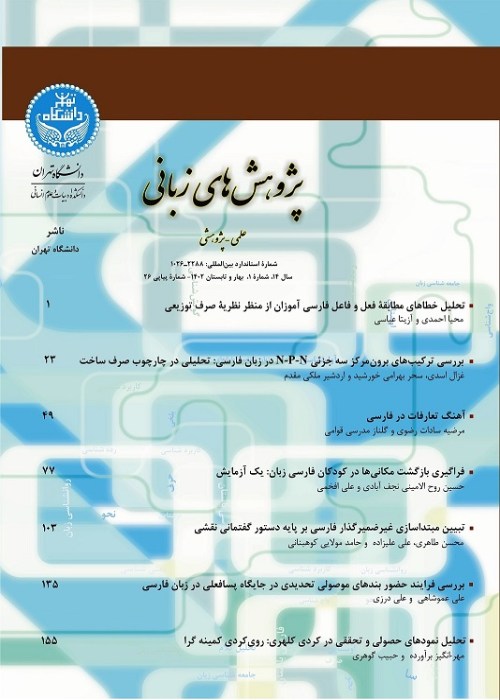Sincerity of Ta’arofs Across Genders in Persian Language: A Cognitive Approach
Author(s):
Article Type:
Research/Original Article (دارای رتبه معتبر)
Abstract:
This paper deals with the sincerity of Persian language Ta’arofs across genders. The sincerity is evaluated by means of cultural schemas. Data that is gathered from different conversational contexts and Iranian films is analyzed by conversation analysis method. Using emic approach, the researchers identify fifteen underlying cultural schemas for Persian Ta’arofs and represent a model. To fulfill this aim, the Ta’arofs with similar illocutionary forces are identified and classified as cultural micro-schemas. Each class is given a title and the first encoding is done. To make sure about the validity of the classifications two inter-raters are employed. Then the concepts which are considered as the basis for these micro-schemas in Iranian culture are identified and labeled as macro-schemas. The Ta’arofs are evaluated in questionnaires in terms of sincerity they are associated with across genders. Ta’arofs and their contexts are presented in the questionnaire and the subjects are asked to evaluate the sincerity of Ta’arofs. Ta’arofs are chosen from both genders’ conversations equivalently and distributed in the questionnaire with different cultural schemas. The evaluation of data demonstrates that despite the common belief that men’s Ta’arofs are more sincere than women’s, there wasn’t any significant difference between their degrees of sincerity. Moreover, considering that the most and the least sincere Ta’arofs belong to women, we can say that the range of sincerity of Ta’arofs is wider in women than in men. The underlying micro-schemas of the most sincere Ta’arofs in women and men are respectively sympathy (Hamdeli) and compliment (Tahsin); and, the underlying micro-schemas of the least sincere Ta’arofs are respectively hospitality (Mehmannavazi) and Shekastehnafsi in women and men. Although the underlying micro-schemas of the most (in) sincere Ta’arofs are different in the two genders and reflect social and psychological differences between them, the underlying macro-schemas obey the notion of distributive cognition.
Keywords:
Sincerity , Ta' , arof , gender , Persian Language , Cognitive approach
Language:
Persian
Published:
Language Research, Volume:10 Issue: 1, 2019
Pages:
21 to 37
magiran.com/p2007447
دانلود و مطالعه متن این مقاله با یکی از روشهای زیر امکان پذیر است:
اشتراک شخصی
با عضویت و پرداخت آنلاین حق اشتراک یکساله به مبلغ 1,390,000ريال میتوانید 70 عنوان مطلب دانلود کنید!
اشتراک سازمانی
به کتابخانه دانشگاه یا محل کار خود پیشنهاد کنید تا اشتراک سازمانی این پایگاه را برای دسترسی نامحدود همه کاربران به متن مطالب تهیه نمایند!
توجه!
- حق عضویت دریافتی صرف حمایت از نشریات عضو و نگهداری، تکمیل و توسعه مگیران میشود.
- پرداخت حق اشتراک و دانلود مقالات اجازه بازنشر آن در سایر رسانههای چاپی و دیجیتال را به کاربر نمیدهد.
دسترسی سراسری کاربران دانشگاه پیام نور!
اعضای هیئت علمی و دانشجویان دانشگاه پیام نور در سراسر کشور، در صورت ثبت نام با ایمیل دانشگاهی، تا پایان فروردین ماه 1403 به مقالات سایت دسترسی خواهند داشت!
In order to view content subscription is required
Personal subscription
Subscribe magiran.com for 70 € euros via PayPal and download 70 articles during a year.
Organization subscription
Please contact us to subscribe your university or library for unlimited access!



